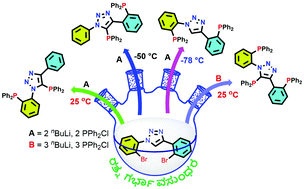New 1,2,3-triazole based bis- and trisphosphine ligands: synthesis, transition metal chemistry and catalytic studies†
Abstract
The syntheses and transition metal chemistry of triazole-based bis- and tris-phosphines, 5-(diphenylphosphanyl)-1-(2-(diphenylphosphanyl)phenyl)-4-phenyl-1H-1,2,3-triazole (2), 5-(diphenylphosphanyl)-4-(2-(diphenylphosphanyl)phenyl)-1-phenyl-1H-1,2,3-triazole (5), 1,4-bis(2-(diphenylphosphanyl)phenyl)-1H-1,2,3-triazole (6) and 5-(diphenylphosphanyl)-1,4-bis(2-(diphenylphosphanyl)phenyl)-1H-1,2,3-triazole (7), are described. Bisphosphines 5 and 6 show versatile coordination behavior due to the presence of at least four donor atoms. The reactions of 5 and 6 with group VI metal carbonyl derivatives were found to be highly sensitive to the reaction conditions. Bisphosphine 5 upon treatment with [M(CO)4(piperidine)2] (M = Mo and W) yielded both P,P and P,N coordinated complexes [M(CO)4(5)] [M = Mo-κ2-P,N (8); W-κ2-P,N (9); Mo-κ2-P,P (10); W-κ2-P,P (11)], whereas 6 afforded only P,N coordinated complexes [{o-Ph2P(C6H4){1,2,3-N3C(o-Ph2P(C6H4))CH}-κ2-P,N}Mo(CO)4] (12) and [{o-Ph2P(C6H4){1,2,3-N3C(o-Ph2P(C6H4))CH}-κ2-P,N}W(CO)4] (13). The reactions of 5 with [M(COD)Cl2] (M = Pd and Pt) yielded κ2-P,P chelate complexes 14 and 15, respectively, whereas the treatment of 6 with [Pd(COD)Cl2] at ambient temperature resulted in the formation of a rare fused six-membered PCP pincer complex [{o-Ph2P(C6H4){1,2,3-N3C(o-Ph2P(C6H4))C}-κ3-P,C,P}PdCl] (16). Similar reactions of 6 with [NiCl2(DME)] and [Pt(COD)Cl2] in the presence of LiHMDS yielded [{o-Ph2P(C6H4){1,2,3-N3C(o-Ph2P(C6H4))C}-κ3-P,C,P}NiCl] (17) and [{o-Ph2P(C6H4){1,2,3-N3C(o-Ph2P(C6H4))C}-κ3-P,C,P}PtCl] (18), respectively. The reaction between 6 and [M(COD)Cl]2 (M = Rh and Ir) produced cationic complexes [{o-Ph2P(C6H4){1,2,3-N3C(o-Ph2P(C6H4))CH}-κ2-P,N}Rh(C8H12)]Cl (19) and [{o-Ph2P(C6H4){1,2,3-N3C(o-Ph2P(C6H4))CH}-κ2-P,N}Ir(C8H12)]Cl (20), respectively, whereas the reaction with [Rh(acac)(CO)2] resulted in a pincer complex [{o-Ph2P(C6H4){1,2,3-N3C(o-Ph2P(C6H4))C}-κ3-P,C,P}Rh(CO)] (21). The structures of most of the compounds have been determined by single crystal X-ray analyses. The fused six-membered PCP palladium pincer complex 16 is found to be an excellent catalyst for the Mizoroki–Heck coupling reaction.



 Please wait while we load your content...
Please wait while we load your content...